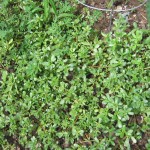 This is a fast growing, delicious and abundant succulent found in most gardens and wherever there is well drained soil and sun. It is more a ground cover than an upright plant and can extend to a foot and a half or more from the main root, with the branches rooting in places where it is in firm contact with the ground. Purslane has been used as a food and a medicinal in the Mediterranean Basin, India, and Asia for thousands of years. The leaves and stems have a slightly crunchy texture and a salty, slightly lemony flavor.
This is a fast growing, delicious and abundant succulent found in most gardens and wherever there is well drained soil and sun. It is more a ground cover than an upright plant and can extend to a foot and a half or more from the main root, with the branches rooting in places where it is in firm contact with the ground. Purslane has been used as a food and a medicinal in the Mediterranean Basin, India, and Asia for thousands of years. The leaves and stems have a slightly crunchy texture and a salty, slightly lemony flavor.
Purslane is of particular note as a readily available supply of Omega 3 fatty acids and is delicious in green salads, sautéed in butter, and can be used 50/50 with sorrel in soups. It can be found in the Middle Eastern salad Fattoush, or pickled with wine or vinegar, garlic, chilli, and whole peppercorns. This succulent is also good in Asian stir-fries, or cooked like spinach.
In the past, purslane was used as a cure for “blastings by lightening or planets”. These days it is finally coming back into culinary use and is one of the very best of the “weeds”! My 3 year old Granddaughter eats it right out of the garden and enjoys it very much. To quote her: “This is delicious, Nini!”
NOTE: The cultivated plant, Portulaca, is related and these colorful flowers are wonderful in salads and as a garnish.
Some of this information on Purslane came from: Reader’s Digest – The Complete Illustrated Book of Herbs; 2011; pg. 96.


